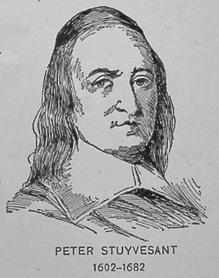| Revision as of 02:50, 8 November 2004 edit24.168.58.76 (talk)No edit summary← Previous edit | Revision as of 02:51, 8 November 2004 edit undo24.168.58.76 (talk)No edit summaryNext edit → | ||
| Line 6: | Line 6: | ||
| Stuyvesant and his family were large land owners in the northeastern portion of New Amsterdam and the Stuyvesant name is currently associated with the ] housing complex, historic ], and ], among others. His farm, known as the 'bouwerie' is the origin of the name ]. | Stuyvesant and his family were large land owners in the northeastern portion of New Amsterdam and the Stuyvesant name is currently associated with the ] housing complex, historic ], and ], among others. His farm, known as the 'bouwerie' is the origin of the name ]. | ||
| As governor Stuyvesant, an ], took measures to make New Amsterdam a city of white people. He restricted and opressed the ], ], and ] populations in the colony. It is with great irony that in 1902 ] in ], a predominantly Jewish school for boys, was named after him. | As governor Stuyvesant, an ], took measures to make New Amsterdam a city of white people. He restricted and opressed the ], ], and ] populations in the colony. It is with great irony that in 1902 ] in ], which was at the time of its founding a predominantly ] school for boys, was named after him. | ||
| Prior to his appointment as governor Stuyvesant served as a director for the ] in charge of the so-called 'abc islands' of ], ] and ]. He lost his leg in a battle with the Portuguese over the island of ] and wore a pegleg for most of his adult life. | Prior to his appointment as governor Stuyvesant served as a director for the ] in charge of the so-called 'abc islands' of ], ] and ]. He lost his leg in a battle with the Portuguese over the island of ] and wore a pegleg for most of his adult life. | ||
Revision as of 02:51, 8 November 2004

Peter Stuyvesant (born 1592 in Scherpenzeel, died 1672) served as the last Dutch governor of the colony of New Netherland before it was turned over to the British Empire.
Stuyvesant's accomplishment as governor included a great expansion for the settlement of New Amsterdam (later renamed New York) beyond the southern tip of Manhattan. Among the projects built by Stuyvesant's administration were the protective wall on Wall Street, the canal which became Canal Street, and Broadway.
Stuyvesant and his family were large land owners in the northeastern portion of New Amsterdam and the Stuyvesant name is currently associated with the Stuyvesant Town housing complex, historic Stuyvesant Street, and Stuyvesant High School, among others. His farm, known as the 'bouwerie' is the origin of the name Bowery.
As governor Stuyvesant, an anti-semite, took measures to make New Amsterdam a city of white people. He restricted and opressed the Jewish, African-American, and Native American populations in the colony. It is with great irony that in 1902 Stuyvesant High School in Manhattan, which was at the time of its founding a predominantly Jewish school for boys, was named after him.
Prior to his appointment as governor Stuyvesant served as a director for the Dutch West India Company in charge of the so-called 'abc islands' of Aruba, Bonaire and Curacao. He lost his leg in a battle with the Portuguese over the island of Sint Maarten and wore a pegleg for most of his adult life.
A Dutch cigarette brand is named Peter Stuyvesant after him. These are popular in Australia, where they are known as 'Stuyvos'.
Categories: